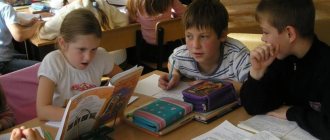Technology of problem-dialogical teaching – master class
Technology of problem-dialogical teaching –
a tool that allows you to solve the problem of changing the paradigm of education - from authoritarian-reproductive to developmental, humanistic, personality-oriented, i.e. build an educational space in which students’ abilities are effectively developed
How did this technology come about? Based on many years of domestic research in two independent areas - problem-based learning (I.A. Ilnitskaya, V.T. Kudryavtsev, M.I. Makhmutov, etc.) and the psychology of creativity (A.V. Brushlinsky, A.M. Matyushkin, A.T. Shumilin and others) have developed a technology of problem-based and dialogic teaching, which allows students to organize independent “discovery” of new knowledge in the classroom. The problem-dialogical method in the system of developmental education allows you to achieve the goal - to form students’ readiness for self-development. To achieve the intended goal, it is necessary to solve a number of the following tasks:
- Conduct diagnostics to determine motives and interest in learning.
- Study the theoretical basis of the experience, select the content of the educational material.
- Draw up a program to implement the assigned tasks. Select
educational activity and its distinctive features, which constitute a problem-dialogic approach to learning;
4. Conduct control diagnostics of levels upon completion of the implementation of the new technology.
5. Organize reflection on your own activities to introduce new technology into practice.
In the process of setting learning goals and analyzing the activities being formed, the content of training must be identified, that is, the answer to the question must be given: “What to teach?” Thus, the idea of my work is to highlight those types of activities that a schoolchild must master, and to build such a lesson structure and didactic conditions for its organization that would systematically train children’s abilities to carry out these types of activities.
Master Class
Activation of cognitive activity through the technology of problem dialogue
Goal: familiarization with the technology of problematic dialogue, training participants in the master class to create a problematic situation.
1. “Teach your child mainly what can be useful to him in life, in accordance with the career that awaits him.” These words belong to the English philosopher and teacher D. Locke. Only through dialogue does the ability to think develop. “In conversation and questioning, conditions are created for the interaction of understanding consciousnesses,” said M. M. Bakhtin (philosopher, literary critic)
2. The technology of problem dialogue can be used in the study of any school discipline and at any educational level and is therefore necessary for every teacher.
What does a teacher need to master technology? A teacher needs only two things to consciously master the technology of problematic dialogue: knowledge and the desire to apply it. THE AUTHOR OF THIS TECHNOLOGY IS Elena Leonidovna Melnikova.
What stages does a problem-dialogical lesson consist of?
Stages of a lesson on problem dialogue technology
1. Creation of a problem situation by the teacher and formulation of the educational problem by the students.
2. Proposing versions of solutions to the problem.
3. Updating existing knowledge.
4. Drawing up a plan to solve the problem.
5. Finding a solution to a problem - discovering new knowledge.
6. Expressing a solution to a problem and applying new knowledge in practice.
Within each topic, significant variations are possible while maintaining the main stages. I will focus on the first stage: the creation of a problem situation by the teacher and the formulation of a learning problem by the students.
The teacher created a problematic situation.
A problematic situation is a state of mental difficulty caused in a certain educational situation by the objective insufficiency of the knowledge and methods of mental and practical activity previously acquired by students to solve the emerging cognitive problem.
Types of problem situations: with surprise and with difficulty
Topic: Spelling nouns with suffixes -chik, -schik-( Grade 5 - Form new words from these words using suffixes
- chick, -chick. Load of stone.
Loader mason
- The suffixes sound the same but are spelled differently.
- Why did this happen? -What don’t we know?
Topic: Hyphen in adverbs (7th grade)
Open parenthesis. Give reasons for your answer.
- He (still) writes beautifully.
- (Follow) the same path
easier.
- Were you able to complete the task?
- Why couldn't they?
- What difficulties did you experience?
- What needs to be done for this?
The student must formulate the problem. And the teacher must create conditions for this. And he does this with the help of two dialogues.
Types of dialogues
Encouraging dialogue
Teacher questions that encourage children to express different versions of how to solve a problem
Leading dialogue
- A chain of questions that consistently lead to the correct answer planned by the teacher
To create a stimulating dialogue, the teacher uses the following techniques (4 of them):
Techniques for creating a problem situation
Technique 1. A problematic situation with contradictory provisions is created by simultaneously presenting contradictory facts, theories, and opinions to the class. In this case, a fact is understood as a single piece of scientific information, a theory is a system of scientific views, and an opinion is the position of an individual. Inducement to awareness of the contradiction is carried out by the remarks: “What surprised you? What interesting things did you notice? What contradiction is there?" The incentive to formulate the problem is carried out by one of two possible replicas of choice.
Technique 2. A problematic situation with a clash of opinions among class students is created by a question or practical task on new material. Inducement to awareness of the contradiction is carried out by the remarks: “Was there only one question? How many opinions?” or “Was there only one task? How did you complete it?” And then the general text: “Why did this happen? What don’t we know yet?” The incentive to formulate the problem is carried out by one of the replicas of your choice.
Technique 3. A problematic situation with a contradiction between the everyday (i.e. limited or erroneous) understanding of students and a scientific fact is created in two steps. First (step 1), the teacher reveals the students’ everyday understanding with a question or practical task “to make a mistake.” Then (step 2) presents a scientific fact with a message, experiment, calculations or visualization. Inducement to awareness of the contradiction is carried out by the remarks: “What did you think at first? What actually turns out to be?” The incentive to formulate the problem is carried out by one of the replicas of your choice.
Technique 4. A problematic situation with a contradiction between the need and the impossibility of fulfilling the teacher’s task is created by a practical task that is not similar to the previous one. Encouraging awareness of the problem is carried out by the remarks: “Were you able to complete the task? What's the problem? How is this task different from the previous one?” The incentive to formulate the problem is carried out by one of the replicas of your choice.
ACCORDING TO THE AUTHORS, technologies that encourage and lead dialogues have advantages and disadvantages.
Encouraging dialogue
+ Develops creative thinking.
+ As close as possible to real-life situations.
— Students can get sidetracked from the topic.
— It is impossible to calculate the time in class.
Leading dialogue
A chain of questions that consistently lead to the correct answer planned by the teacher
+ Develops logical thinking.
+ Calculated by time.
+ Leads to the desired result in a short way.
— To a lesser extent develops creativity and initiative.
It is fundamentally important:
- alternate forms of work: individual, pair, group with general conversation; -invite students to talk about the results of completing the task so that monologue speech develops.
Advantages of problem dialogue technology
- Problem dialogue is a powerful source of motivation for students’ cognitive activity.
- Problem dialogue is implemented at any level of education.
- Problem dialogue gives the teacher wide opportunities to choose methods, forms and means of teaching.
- Almost the entire class is involved in the work, which guarantees that the majority of students will master the new material.
- Provides better assimilation of knowledge, teaches students to think, develops their intellectual abilities and activity.
What educational results does problem-dialogical technology provide?
- Regulatory: problem solving skills. Goal setting, drawing up an action plan, control, correction, assessment and self-esteem, etc.
- Communication skills: ability to conduct a dialogue. The ability to listen and engage in dialogue, cooperation with peers and adults, conflict resolution, decision making and its implementation, etc.
- Cognitive: extract information, draw conclusions, etc. Research, search, selection of necessary information, semantic reading, etc.
- Personal: if the problem of moral assessment of the situation, civil choice was raised. Personal, professional, life self-determination, assessment of the situation, moral choice, etc.
The technology of problem dialogue really ensures the creative assimilation of knowledge: “I asked, discovered, created”
Literature
1.Melnikova E.L. Problem lesson, or how to discover knowledge with students: A manual for teachers. - M., 2012.
2.Melnikova E.L. Technology of problem dialogue: methods, forms, teaching aids // Educational technologies. Collection of materials. M., Balass, 2010.




